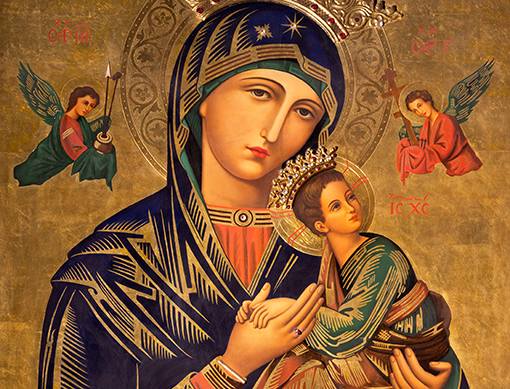Mary is honored as Mother of God and Queen of Heaven. These grand titles may make her seem too high or unapproachable, but the Church wants us to feel free to run to Mary and be comforted in her loving arms. The Christmas season can magnify the stresses on families. Recognizing the gentle motherhood of Mary is important for children, and all of us, during this time of the year. We all need to be reminded that Mary and her Newborn Son love them, and that Mary can be our role model of compassion.
 In a homily on the Feast of the Solemnity of Mary, Mother of God on New Year’s Day, Pope Francis urged us to learn how to be like Mary: “How important it is to educate our hearts to care, to cherish the persons and things around us. Everything starts from this: from cherishing others, the world and creation. …Mary, who know how to cherish things in your heart, care for us, bless our time, and teach us to find time for God and for others."
In a homily on the Feast of the Solemnity of Mary, Mother of God on New Year’s Day, Pope Francis urged us to learn how to be like Mary: “How important it is to educate our hearts to care, to cherish the persons and things around us. Everything starts from this: from cherishing others, the world and creation. …Mary, who know how to cherish things in your heart, care for us, bless our time, and teach us to find time for God and for others."
Approaching Mary in Art: We know this from the centuries of Christian art. Any painting or statue of Mary you see presents her as mild and concerned for us, God’s children. I am especially drawn to “Our Lady of Perpetual Help.” When I was a young mother, this image of Mary, painted in the Byzantine style, was in a place of honor in our parish church. An icon is called a “window into heaven,” and that is how I experienced it when I contemplated it. I felt Mary was looking right at me! She is holding young Jesus, who has just leapt into her arms in terror. He is having a vision of angels holding the implements of his future torture. He is literally scared out of his sandals, which dangle untied. In this dramatic scene, Mary comforts her little son, holding both of his hands, but she is looking at us, not him. She seems to say, “What will you do for Jesus?”
Explore Images of Mary. The Student Editions of Blest Are We Faith in Action and Be My Disciples include many beautiful images of saints, especially Mary. Have your students find one image of Mary that attracts them. Let them describe the image to the class, and write a list of words to describe Mary as they see her. Compose a prayer to Mary based on the word lists and pray it as a group.
Imagine Being with Mary: Invite students to imagine themselves in place of Mary in the Christmas Gospels (Luke 2 and Matthew 1-2). Have them write down some thoughts or draw a picture from the Nativity stories, with themselves in the scene.
Mary’s Many Titles. Mary has many other titles in Catholic Tradition, many given to her by people who experienced her presence in a mysterious way. When people tell their stories about Mary, they have a common theme: She continues to advocate for us in heaven. Look for the Mary, Our Lady packet here, available for free download.
 About the Author
About the AuthorDr. Lauri Przybysz specializes in equipping families to live their vocation to be domestic churches and signs of God’s love. Lauri received the Doctor of Ministry from the Catholic University of America, and she has been both a Catholic middle school religion teacher and a faith formation coordinator at the archdiocesan and parish levels. She is the mother of six children and grandmother of 21.
Years ago, I sat in on a religion class for kindergarten students in one of our Catholic schools. They gathered on a carpet in front of their teacher who had initiated a “discussion” about bosses. It was during a time when, “You’re not the boss of me!” was a common expression among youth.
 I could see the teacher was helping them come to an understanding about responsibility and respect, and the reality that everyone has someone to answer to.
I could see the teacher was helping them come to an understanding about responsibility and respect, and the reality that everyone has someone to answer to.
“Do you know who my boss is?” the teacher asked the children.
“Ooh, ooh, I know, I know!” came multiple voices with outstretched, waving arms.
“Mrs. Fischer!” yelled out one impatient five-year-old, referring to the school principal.
“Very good!” said the teacher. “Now, does anyone know who the Pope’s boss is?”
I was pleasantly surprised that most students seemed to know who the Pope was and noticed a picture of Pope John Paul II on the wall near the prayer corner.
Once again, hands shot up and students strained to almost jumping to their feet. I’m sure the teacher was expecting to hear an enthusiastic, “God!” But before she could call on any one student, the same very engaged five-year-old yelled out, “His mom!”
It was priceless!
Learning about the Pope as leader of the Catholic Church is an important element of faith formation, as is knowing something about the man who has become the Pope. In the case of Pope Francis, we knew from the moment he was elected that he was a humble man of prayer.
His first words to the people as he stood on the balcony of St. Peter’s Basilica after being elected by the conclave of cardinals were: “First of all, I would like to say a prayer for our bishop emeritus, Benedict XVI. Let us all pray together for him; let us all pray together for him so that the Lord may bless him, and that the Madonna may protect him.”
After praying the “Lord’s Prayer,” the “Hail Mary” and the “Glory Be” with the crowd, the Holy Father continued, “And now, let us start this journey, bishop and people, bishop and people, this journey of the Church of Rome, which leads all the Churches in charity, a journey of fraternity, of love, of trust among us.
Let us always pray for us, one for the other, let us pray for the whole world, so that there may be a great fraternity. I hope that this journey of the Church that we begin today and which my cardinal vicar, who is here with me, will help me with, may be fruitful for the evangelization of this beautiful city.
“Now, I would like to give you a blessing, but first I want to ask you for a favor. Before the bishop blesses the people, I ask that you pray to the Lord so that he blesses me. This is the prayer of the people who are asking for the blessing of their bishop. In silence, let us say this prayer of you for me.”
So, it is no surprise that Pope Francis releases a list of monthly prayer intentions each year and asks the faithful to join him in praying for those specific intentions. What may come as a surprise is the fact that the Apostleship of Prayer, founded by Jesuit seminarians in France, has received monthly, universal prayer intentions from the Pope since the late 1800s. An additional missionary intention was added by the Holy Father in 1929.
Certainly, prayer has long been at the heart of the Church, and the monthly prayer intentions of Pope Francis provide an opportunity for students to not only pray, but to discuss the many important current issues that benefit from the prayers of the faithful.
Teachers who are interested in incorporating Pope Francis’ prayer intentions into their classroom prayers may find the monthly list of Pope Francis’ prayer intentions for 2023 and information on how prayer intentions are chosen at Pope’s Worldwide Prayer Network, Apostleship of Prayer.
Of interest for teachers, January’s prayer intention is for educators: “We pray that educators may be credible witnesses, teaching fraternity rather than competition and helping the youngest and most vulnerable above all.”
 About the Author
About the AuthorMary Clifford Morrell, mother of six and grandmother to ten, is a Catholic journalist, editor, and author who has served the Dioceses of Metuchen and Trenton, New Jersey; Burlington, Vermont, and RENEW International in the areas of religious education and communication.
Today our children are influenced by the values of culture through places like YouTube where everyone is determined to become rich and famous, and through videos, movies and TV where they are introduced regularly to the latest iteration of the superhero.
 Providing them with alternative ways of thinking is a fruit of religious education.
Providing them with alternative ways of thinking is a fruit of religious education.
Consider St. Andrew, the Apostle who is rarely spoken of in Scripture, but who was, with his brother Peter, chosen by Jesus as his first Apostles. Andrew wasn’t rich, or famous or well educated. He was a fisherman, an ordinary working man. You might say, as a YouTuber, he wouldn’t have many followers.
But it was in his littleness, that St. Andrew was strong.
St. Andrew “was searching for something more important than life on the sea could give him. Like many faithful Jews of his time, Andrew was waiting for God to send the Savior he had promised” (Saints Resource, RCL Benziger).
So, when Andrew and a friend heard John the Baptist exclaim one day, “Behold, the Lamb of God” as Jesus walked by, they immediately followed Jesus, who then invited the two to join him. Andrew was so excited he ran to get his brother, Peter, and share the good news with him and bring Peter to Jesus.
Later, in their ministry, Andrew would bring the young boy with five loaves of bread and two fish to Jesus who would use that small boy and those fish to feed more than 5,000 people.
That’s about all we know about Andrew from Scripture. This Apostle didn’t seek the limelight, but he never let his relatively unknown status keep him from doing God’s work. After Pentecost, Andrew brought Jesus to others through his preaching in Greece and Russia, until, like Jesus, he was martyred on a cross, though his cross was in the shape of an X because he didn’t consider himself worthy of being crucified in the same manner as his Lord, Jesus.
What were St. Andrew’s unique characteristics?
Humble – Imagine you met the President of the United States who was looking to fill an important decision in his/her Cabinet. You are so excited you run off to get your sibling to meet the President, too. And when it’s time to select the person for the important Cabinet post, the President selects your sibling. How would you feel? You’d think Andrew might have been angry and jealous that his brother, Peter, was chosen by Jesus as the leader of Christians, but instead he continues his service by going to foreign lands as a missionary for Christ. Andrew understood that you can’t be filled with the love of God is you are filled with an unhealthy love of self.
Faithful – St. Andrew followed Jesus from the first moment he realized Jesus was the savior God had promised to send his people. He accepted Jesus’ invitation to “come and see,” and never turned back. He continued his mission to preach the Good News of the Gospel to all nations even though he knew there was great danger in doing so. Our students will grow in faith with opportunities to pray, read the Word of God and to respond to invitations to learn what Jesus is all about.
Insightful –We see Andrew has insight when he recognizes Jesus as the Lamb of God, as described by John the Baptist, and when he realizes that Jesus could make something great out of the littleness of five loaves of bread and two fish. Andrew has the gift of being able to see what many others can’t see, the ability to observe well, make connections and imagine possibilities. Helping students develop insight will help them be successful in all areas of their lives.
Moving Forward
Not every lesson in a classroom should come from a textbook. Lessons about religion and faith are often learned more deeply from experiences and nurtured by the shared wisdom of adults in their lives. These are the elements that can help children develop the varied characteristics of the saints and Apostles, helping them to understand that even in their own littleness they can have a powerful, positive impact on the world.
Provide opportunities for students to share the “small” moments of faith they have witnessed or experienced, and to talk about the outcome or what it meant to them. For example, when they witness a classmate sharing lunch or pencils with another classmate, helping someone with their homework, or standing up for a classmate who is being treated poorly by another classmate.
Keep a small bowl of water on a windowsill and let students drop a small pebble in so they can see the ripples the pebble creates. Remind them that every kind word or good action, no matter how small, creates a ripple in other lives.
Display this quote: “I alone cannot change the world, but I can cast a stone across the waters to create many ripples.” – Mother Teresa
 About the Author
About the AuthorMary Clifford Morrell, mother of six and grandmother to ten, is a Catholic journalist, editor, and author who has served the Dioceses of Metuchen and Trenton, New Jersey; Burlington, Vermont, and RENEW International in the areas of religious education and communication.
As the new Church year begins, the Catholic significance of the change of seasons is a profound reminder that our lives are finite, and that time should not be squandered. But more than anything, it reminds us that time is a gift from God, and with him and through him, all things are holy, and nothing is without meaning. God gives us each day “our daily bread,” and even gives us a whole day each week – Sunday -- to recharge our batteries.
 In response, we must be good stewards of time. We are often overwhelmed with an ever-growing list of events. Sunday can become a frantic catch-up day. Imagine taking Sunday off and really resting from work that drains us! How could we manage our time better in order to live a more balanced, less stressful life?
In response, we must be good stewards of time. We are often overwhelmed with an ever-growing list of events. Sunday can become a frantic catch-up day. Imagine taking Sunday off and really resting from work that drains us! How could we manage our time better in order to live a more balanced, less stressful life?
St. John Paul II urged us: “Do not be afraid to give your time to Christ. Yes, let us open our time to Christ, that he may cast light upon it and give it direction. He is the One who knows the secret of time and the secret of eternity, and he gives us “his day” as an ever-new gift of his love. …Time given to Christ is never time lost, but is rather time gained, so that our relationships and indeed our whole life may become more profoundly human.” (Dies Domini, no. 7)
Activity on Time Management: Assign pairs of students to read and discuss one of these Bible verses and make a list of how they spend their time. Examples: Play outside, play video games, sleep, go to Mass, eat meals, bathe, take care of pets, go to school, visit family.
- Ephesians 5:15-16. “Watch carefully then how you live, not as foolish persons but as wise, making the most of the opportunity, because the days are evil.” What are some foolish distractions that get in the way of using our time wisely?
- Psalm 90:2,12. “Lord, you have been our refuge through all generations. Before the mountains were born, the earth and the world brought forth, from eternity to eternity you are God. …Teach us to count our days aright, that we may gain wisdom of heart.” How can we make good use of our time to show love to our friends and family?
- James 4:8. “Draw near to God, and he will draw near to you.” What are some ways you can move closer to God?
Next, distribute index cards. Have students write one item from the list of priorities (from the Bible activity) on each card or note. Gather the cards from all the students and read them aloud without naming the sources. Ask the class to put the items in order of importance. Close the activity by praying, “O God, direct us to make any changes we need to make in our use of time.”
More on receiving Sunday: more ideas for enjoying and observing the Sabbath Day.
 About the Author
About the AuthorDr. Lauri Przybysz specializes in equipping families to live their vocation to be domestic churches and signs of God’s love. Lauri received the Doctor of Ministry from the Catholic University of America, and she has been both a Catholic middle school religion teacher and a faith formation coordinator at the archdiocesan and parish levels. She is the mother of six children and grandmother of 21.
Advent is a beautiful time in the Church, a time of prayer, fasting, reflection, hope and rituals all meant to remind us of God’s limitless love, born on Christmas day in a manger in Bethlehem.
 Christians in countries all over the world celebrate Advent with a variety of customs and traditions: Advent wreaths and candles, Advent calendars, often stocked with chocolate treats, early morning daily Mass, special foods, cakes and cookies often placed around the Advent wreath, and preparations of all kinds to get ready for the birth of Christ.
Christians in countries all over the world celebrate Advent with a variety of customs and traditions: Advent wreaths and candles, Advent calendars, often stocked with chocolate treats, early morning daily Mass, special foods, cakes and cookies often placed around the Advent wreath, and preparations of all kinds to get ready for the birth of Christ.
In my home, at the beginning of Advent, I take out a tiny dollar store snow globe, complete with snowman inside, and place it next to an icon of Mary and small prayer candle. The ornament is meaningful to me because of the name printed on the front – Joan. It was meant as a gift to be added to my friend Joan’s Christmas tree, but she died before I could give it to her.
Now it serves as an opportunity to reflect daily on the joy of friendship and the power of love especially in the Works of Mercy, lessons that Joan continues to teach me through how she lived her life.
Joan was a woman whose simple and sincere devotion to family and friends was extraordinary. Generosity and compassion were her hallmarks, not just for her friends and family but anyone who she knew needed something. Even during her own difficult times, Joan would help fill Thanksgiving baskets for parish families in need, buy gifts for the Jesse Tree, or bring groceries and home cooked food to friends who were sick or in need.
Joan’s faith was faith in action, not meant to change to world, but to let those around her know they were valued.
Most recently I recalled Joan’s remarkable heart when I read a homily by Pope Francis about the meaning of the Works of Mercy as sharing the suffering of others.
The Holy Father stressed, “We do not do works of mercy to assuage our consciences, to make us feel better. Rather, the merciful person is the one who has pity on others and shares in their suffering. We must ask ourselves, am I generous? Do I know how to put myself in another person’s shoes? Do I suffer when I see another person in difficulty?”
With Advent being a time of reflection and introspection, these questions are important for students to consider, as well, to help them understand that their Catholic faith should be a part of all their decisions and behaviors, especially how they treat others.
How can we bring Works of Mercy into the Advent season in the classroom?
- Display the Works of Mercy on a piece of poster board, or on the chalk or white board throughout Advent. Use it to discuss the Church’s teaching on the Works of Mercy, which are described in the Catechism of the Catholic Church as, “charitable actions by which we come to the aid of our neighbor in his spiritual and bodily necessities.”
- Encourage students to share their thoughts about mercy and to give examples of when they have seen others do Works of Mercy, or when they have shown mercy. Young children may be able to put this in the context of being merciful to animals or younger siblings. Use some version of Pope Francis’ questions, depending on children’s ages, to start children thinking – Am I generous? Am I able to put myself in another person’s shoes? Do I suffer when I see another person in difficulty? For older children, you may want to include a question about times they failed to practice a Work of Mercy when they might have.
- Brainstorm with students for ways in which they may practice Works of Mercy as a class. You may offer a few suggestions to get them started – Make Christmas cards for children who are hospitalized or for homebound parishioners; have older students read Christmas stories to younger students; encourage students, with parents’ help, to bring in canned or dried food for a local/parish food bank, have children work in pairs, or teams, sorting the items and putting them in bags or boxes; encourage students to eat lunch with someone they don’t know well; have older students bring in news stories about a Work of Mercy being done in their communities.
- Pray every day with the students during Advent. Provide them with a simple prayer to say, perhaps after lighting an Advent candle: Dear God, may the Holy Spirit help me understand why we should practice the Works of Mercy and show me those times when someone needs me to show them mercy. Amen” Or, give students the opportunity to create their own prayer with words or pictures that may be hung up in the classroom. Written prayers may be prayed as a class so different prayers are said daily.
- For teachers and staff, Pope Francis’ words from a 2013 homily provide a meaningful reflection: “We must come out of ourselves, we must take human routes if we are to discover that Jesus’ wounds are still visible today on the bodies of all our brothers and sisters who are hungry, thirsty, naked, humiliated or slaves, in prisons and hospitals. By touching and caressing these wounds we can adore God alive in our midst.”
 About the Author
About the AuthorMary Clifford Morrell, mother of six and grandmother to ten, is a Catholic journalist, editor, and author who has served the Dioceses of Metuchen and Trenton, New Jersey; Burlington, Vermont, and RENEW International in the areas of religious education and communication.
In the noisy world of social media, an “influencer” is someone who suggests a product they may never have used to their audience of people that listen to what they have to say. By this definition, influencers are selling something they may or may not believe in. They attract an audience by the force of their personality, but their hearts may not be in their flashy words.
 Catholic teachers do want to be influencers, but with a vital distinction: we aim to authentically share the faith we believe in with our students and their families. A better term to describe us would be “evangelist.” Unlike flashy social media influencers, evangelists practice what they preach. In the media world, evangelizers not only show you products or ideas but they also believe in them and use them themselves. As teachers of the Catholic faith, we aim to positively influence our students by the sharing in the Good News in both word and action. When we teach from our personal convictions about our faith, we hope to build our students into “evangelizing influencers” who will carry on the mission of Jesus.
Catholic teachers do want to be influencers, but with a vital distinction: we aim to authentically share the faith we believe in with our students and their families. A better term to describe us would be “evangelist.” Unlike flashy social media influencers, evangelists practice what they preach. In the media world, evangelizers not only show you products or ideas but they also believe in them and use them themselves. As teachers of the Catholic faith, we aim to positively influence our students by the sharing in the Good News in both word and action. When we teach from our personal convictions about our faith, we hope to build our students into “evangelizing influencers” who will carry on the mission of Jesus.
- Professional Development. Each of us can recall a teacher who influenced us and whom we consider a role model. What qualities did that teacher possess that made a difference for you? How do you hope to emulate that special teacher? Being an influential teacher starts with who you are. If you develop positive qualities in your own life, your students will see them and copy them. Here are some positive qualities to consider:
- Be an affirming teacher by giving the praise they crave.
- Be a visionary teacher, seeing and communicate a picture of their future.
- Be a celebratory teacher who commemorates milestones and successes.
- Be a comforting teacher by creating a safe space in your classroom.
- Be a patient teacher. Count to 10 when situations get stressful.
- Be an attentive teacher. Listening well to hear what they don’t say. •
- Be a prayerful teacher who demonstrates reverence and love for God.
- More on Student Wellbeing. Listen to the research-based webinar by RCL Benziger expert, Susan Ferguson, “Catholic Schools Celebrate Social, Emotional & Spiritual Wellness."
- Thanking Our Role Models. Write a letter of appreciation to a favorite teacher in your own life. If they are living and you know how to reach them, send the letter. Even if you have lost touch, write the letter anyway. Consider sharing the letter with your students and telling them your story. Invite students to write a letter of appreciation to someone who has positively influenced them.
- Resources for Managing the Influence of Social Media. Sign on to your Flourish account for the Family Life Series to access resources to share with parents. Under Catholic Parenting 101, see “Navigating the Shoals of Online Social Networks,” by psychologist Dr. Tim Hogan. In Videos from Experts, see Dr. Hogan’s video, Children and Electronic Media, and view family ministry expert Dr. David Thomas’ short videos on Competing Influences, Part 1 and Part 2.
 About the Author
About the AuthorDr. Lauri Przybysz specializes in equipping families to live their vocation to be domestic churches and signs of God’s love. Lauri received the Doctor of Ministry from the Catholic University of America, and she has been both a Catholic middle school religion teacher and a faith formation coordinator at the archdiocesan and parish levels. She is the mother of six children and grandmother of 21.
As we enter the season of Advent and wait for Christmas, our students are already eagerly anticipating the tree and presents and vacation. It can be a hectic time at school. In the midst of all the excitement, I invite you to spend a while thinking about what Advent can teach you, the teacher, about patiently waiting. It can be hard to have patience, yet teaching demands so much of it! Use this time to learn how to slow down and trust God’s care for you.
 It is easy to miss the blessings Advent has in store for us. In the days leading up to Christmas, we are tempted to immerse ourselves in shopping and cooking—and that after a full day in the classroom! The Scriptures hold lessons about developing patience by practicing fruitful waiting. In Ecclesiastes 3:1, we learn there is a time for everything. During Advent, there is a time for parties and decorating; let us also make a time for relaxing and spending time enjoying quiet visits with a friend we have missed lately. These words from Psalm 37 remind us to place our trust in God to fulfill our heart’s desires: “Find your delight in the Lord who will give you your heart’s desire. Commit your way to the Lord; trust in him and he will act. And make your righteousness shine like the dawn, your justice like noonday. Be still before the Lord; wait for him. Do not be provoked by the prosperous, nor by malicious schemers.” Instead of exhausting ourselves, let us try to savor the blessings of waiting for God to appear.
It is easy to miss the blessings Advent has in store for us. In the days leading up to Christmas, we are tempted to immerse ourselves in shopping and cooking—and that after a full day in the classroom! The Scriptures hold lessons about developing patience by practicing fruitful waiting. In Ecclesiastes 3:1, we learn there is a time for everything. During Advent, there is a time for parties and decorating; let us also make a time for relaxing and spending time enjoying quiet visits with a friend we have missed lately. These words from Psalm 37 remind us to place our trust in God to fulfill our heart’s desires: “Find your delight in the Lord who will give you your heart’s desire. Commit your way to the Lord; trust in him and he will act. And make your righteousness shine like the dawn, your justice like noonday. Be still before the Lord; wait for him. Do not be provoked by the prosperous, nor by malicious schemers.” Instead of exhausting ourselves, let us try to savor the blessings of waiting for God to appear.
- For Your Reflection: Consider this wisdom about patient trust from Pierre Teilhard de Chardin, a French Jesuit priest, scientist, paleontologist, theologian, philosopher and teacher (d. 1955): “Above all, trust in the slow work of God. We are, quite naturally, impatient in everything to reach the end without delay. …Only God could say what this new spirit gradually forming within you will be. Give our Lord the benefit of your believing that his hand is leading you, and of your accepting the anxiety of feeling yourself in suspense and incomplete.” (Excerpted from Michael Harter, SJ, Hearts on Fire: Praying with Jesuits, Chicago, IL: Loyola Press, 2004, 102-103)
- Faith Sharing with Your Students: How have you seen God at work recently? What person do you hope to see at Christmas that you have been missing? What makes you feel joyful?
- Advent Resources for Classroom and Home: Download instructions here for making a Jesse Tree or an Advent Wreath with your students, pray the O Antiphons, or honor our Lady of Guadalupe. You will also find ideas to send home for families to celebrate a more fruitful waiting time.
- More Advent Projects: Log on to your Flourish account to download Advent activities in the Feasts and Seasons section of the Blest Are We Faith in Action Activities and Projects for your grade level.
 About the Author
About the AuthorDr. Lauri Przybysz specializes in equipping families to live their vocation to be domestic churches and signs of God’s love. Lauri received the Doctor of Ministry from the Catholic University of America, and she has been both a Catholic middle school religion teacher and a faith formation coordinator at the archdiocesan and parish levels. She is the mother of six children and grandmother of 21.
The Advent season, which begins on Sunday, Nov. 27 this year, is the first gift of Christmas, but one that is often unwrapped.
Advent is comprised of four weeks set aside in the liturgical calendar to prepare the home of our heart for the birth of Jesus and the always perfect Christmas of Bethlehem. It is a time to recall the unrivaled, unconditional love of God which we find in the manger on Christmas morning.
 It is also one of the least understood seasons of the Church with the reflective nature of this time often co-opted by the frantic pace with which we plan for Christmas – the decorations, the food, shopping for gifts; the mindset that buying is at the heart of the season deprives us of what should be a time to breath, to wonder, to anticipate the joy that comes with Christmas.
It is also one of the least understood seasons of the Church with the reflective nature of this time often co-opted by the frantic pace with which we plan for Christmas – the decorations, the food, shopping for gifts; the mindset that buying is at the heart of the season deprives us of what should be a time to breath, to wonder, to anticipate the joy that comes with Christmas.
In his book, “A Pilgrims Almanac,” Edward Hayes reminds us, “Take time to be aware that in the very midst of our busy preparations for the celebration of Christ’s birth in ancient Bethlehem, Christ is reborn in the Bethlehems of our homes and daily lives. Take time, slow down, be still, be awake to the Divine Mystery that looks so common and so ordinary yet is wondrously present.”
While teachers cannot change the culture in which students find themselves, religious education classes in both Catholic schools and parish programs may be infused with the beautiful, faith-filled meaning of this holy holiday season.
Prepare the way of the Lord - Give your students the gift of Advent by including them in classroom preparations for welcoming the Baby Jesus. Preparations can include straightening out desks, books shelves, cloak rooms and reading nooks. Share in rearranging the classroom prayer table or corner for Advent, with colors of purple and rose, and an Advent wreath.
It’s important to acknowledge that some families do not go to Mass regularly so children may not see the Advent candle lit in church. Having an Advent wreath in the classroom allows for discussion of the symbolism and the colors and reason to celebrate.
Prayerfully decorate – Give children an opportunity to create decorations for the classroom. In addition to the red and green of Christmas, add purple, the color of Advent symbolizing prayer, penance and sacrifice. Include one or more religious themed Advent calendars to ensure that every child has a chance to open one of the days. Offer an Advent prayer before or after any project.
Gift students with listening moments – Spiritually, Advent is a time to breath, a time to reflect on who we are and who we should be in relation to the Christ child. Young children are not ready for such reflection but providing them times of quiet will prepare them for reflective experiences as they get older.
Times of quiet also help calm busy minds and bodies and keep them connected with things outside themselves. It is also an important aspect of prayer. Provide a few minutes of quiet. Direct students to take a few deep breaths, then ask students to listen to the quiet. At the end of a few moments, ask them to share what they heard – birds or cars going by outside, students or teachers talking in the hallways, the clock on the wall ticking.
Encourage them to imagine what Mary and Joseph might have heard in the quiet the night Jesus was born. Would they have heard the shepherd and sheep off in the distance as they came to visit the newborn King? Would they have heard the three Wise Men on their camels as they came bearing gifts? After any sharing, end with a short prayer, “Thank you God, for time to listen and think about Jesus during Advent.”
In addition to the lessons and information in the RCL Benziger student, teach, and catechist curriculum guides, plan to look at the free, downloadable Advent resources, as well.
 About the Author
About the AuthorMary Clifford Morrell, mother of six and grandmother to ten, is a Catholic journalist, editor, and author who has served the Dioceses of Metuchen and Trenton, New Jersey; Burlington, Vermont, and RENEW International in the areas of religious education and communication.
On Nov. 11, the United States celebrates Veterans Day, a day to honor those who served in military service for their country. As Catholics, we also pray for the repose of the souls of all those who died defending their country. Across the country celebrations include parades and other observances and a ceremony at the Tomb of the Unknown Soldier at Arlington National Cemetery in Virginia.
 Nov. 11 is also the day when Catholics honor St. Martin of Tours, the patron saint of soldiers, who was a soldier and veteran himself. The celebration of St. Martin’s feast day known as Martinmas originated in France, and spread to many places including Britain, Germany, Scandinavia and Germany. In the United States, celebrations usually take place within communities that share a cultural heritage.
Nov. 11 is also the day when Catholics honor St. Martin of Tours, the patron saint of soldiers, who was a soldier and veteran himself. The celebration of St. Martin’s feast day known as Martinmas originated in France, and spread to many places including Britain, Germany, Scandinavia and Germany. In the United States, celebrations usually take place within communities that share a cultural heritage.
When Martin was a young boy, he learned about Christ and began studying to become a Christian. At 15, however, he was called into the Army and served as a Roman soldier. Tradition recalls that, one day, he met a very poor, shivering beggar with few clothes at the city gate. Martin wanted to help him but had nothing but his own clothes. He decided to divide the heavy cloak he was wearing in half and gave half to the beggar so he could be warm.
That night, Martin had a dream in which Jesus appeared to him wearing Martin’s cloak and told the angels surrounding him that Martin gave him the cloak. Martin went right away to be baptized and became a Christian. He asked to be relieved of duty from the army, telling his commander he was now a soldier of Christ.
When he was finally relieved from duty, Martin became a monk, preaching and serving the poor and needy. His holiness became legendary and, as he founded monasteries, many new monks and converts joined him. This humble and gentle servant of God was so loved, the people of Tours demanded he serve as their bishop.
In his humbleness, Martin declined, so they tricked him into coming to the church for consecration by telling him he was needed to heal a sick woman. When he realized what had happened, Martin hid in a barn, but a large gaggle of geese made so much noise they gave him away.
Martin agreed to become bishop and serve God’s people. He built many churches, fought heresies, and continued to care for the sick, poor and needy. He also worked to save the lives of prisoners, especially heretics who were usually executed.
Martin was also known as Martin the Merciful, which makes him a perfect saint for the coming season of Advent when we are reminded of the importance of the Spiritual and Corporal Works of Mercy.
Some of St. Martin’s decisions based on his faith in God were: studying to become a Christian, leaving military service in the Roman army, becoming a monk, sharing his cloak with a beggar, being baptized and overcoming his reluctance to become Bishop.
St. Martin’s example is a strong one for youth, too, because though Martin became a saint, he was also a normal human being like them. He was faced with many decisions each day. Helping students look at their decisions in the light of faith is an important aspect of faith formation.
Given the many sources of information and experiences youth today face, all of which have an influence on both their conscience and decision-making abilities, the religious education classroom is a powerful place for children to learn good decision making. Prayer, Scripture, Gospel readings, stories of saints and discussions about shared experiences help students to develop their conscience in-line with their faith.
Read more about St. Martin of Tours in Saints Resource.
 About the Author
About the AuthorMary Clifford Morrell, mother of six and grandmother to ten, is a Catholic journalist, editor, and author who has served the Dioceses of Metuchen and Trenton, New Jersey; Burlington, Vermont, and RENEW International in the areas of religious education and communication.
In the New Testament, Jesus is often moved to mercy through compassion. Jesus' compassion prompts Him to act and He mercifully loves, heals and rescues. Jesus' very presence in the world is the ultimate act of compassion. Compassion literally means “to suffer together.” Jesus says, “Come to me, all who are weary and heavy-laden, and I will give you rest. Take my yoke upon you and learn from me, for I am gentle and humble in heart, and you will find rest for your souls. For my yoke is easy and my burden is light.” (Matthew 11:28-30).
 As Christians, we believe that God stands with the suffering, the marginalized, and the lost. God mourns with every life lost, every tragedy experienced, every human rights violation or injustice or crime. Pope Francis, in the Joy of the Gospel, tells us, “Every human being is the object of God’s infinite tenderness, and he himself is present in their lives. Jesus is our model for tenderness and compassion.
As Christians, we believe that God stands with the suffering, the marginalized, and the lost. God mourns with every life lost, every tragedy experienced, every human rights violation or injustice or crime. Pope Francis, in the Joy of the Gospel, tells us, “Every human being is the object of God’s infinite tenderness, and he himself is present in their lives. Jesus is our model for tenderness and compassion.
Compassion Lesson. Invite students to reflect and respond to the following questions. Do not collect papers or require students to show their answers, but allow them to share if they feel comfortable. Do this activity yourself, and share your answers if it seems helpful.
- Think about your family. Does anyone in your family need your sympathy right now? Who needs your understanding? How do you show compassion in your family? How do people in your family show compassion to you?
- When is compassion needed on the playground? What does compassion look like on the playground? Have you ever felt special understanding from some person on the playground?
- In your school class, who needs to be compassionate and when?
Empathy vs. Compassion. Sometimes we use the words compassion and empathy as synonyms, but there are several important differences between the two words. Empathy is feeling another person’s pain, whereas compassion is taking action to relieve the suffering of others.
In the Family Life program, students learn how to recognize hurtful or selfish behaviors and build healthy friendships and family relationships. When we act with compassion, we are acting like Jesus—the goal of every Christian life.
Solidarity Activity. The concept of “solidarity” is a part of Catholic Social Teaching that guides us to have empathy for people experiencing injustice and take compassionate action.
Classroom Activity: Discuss the immigrant experience of the Holy Family as they fled Bethlehem for Egypt to live among strangers until it was safe to return to their homeland. Compare their experience with that of a refugee family from another country fleeing to the United States to seek asylum. Have students role-play the two experiences, or share their reflections through a poem or in a drawing.
Professional Development for Compassion. When we know more about the impact of stressful experiences – like the Pandemic -- we can grow in tenderness. Understand more about the impact of trauma on your students (and on ourselves) in the webinar recording, Ready to Learn: Trauma - Informed Strategies for Navigating Behavior by Amy Kronberg, M.S.Ed, contributing writer of Stories of God’s Love Early Childhood program.
 About the Author
About the AuthorDr. Lauri Przybysz specializes in equipping families to live their vocation to be domestic churches and signs of God’s love. Lauri received the Doctor of Ministry from the Catholic University of America, and she has been both a Catholic middle school religion teacher and a faith formation coordinator at the archdiocesan and parish levels. She is the mother of six children and grandmother of 21.
Product Highlight
Family Life Second Edition
Family Life Second Edition is the newly updated edition of RCL Benziger's leading K-8 supplemental program that addresses key concerns of today's Catholic families. Family Life includes child safety education in every grade level, promotes virtuous living, and strengthens Catholic identity.
The Family Life program reinforces the Catholic virtues and values that your students attain with their education. Family Life is essential to your school-based religious education program and meets Social and Emotional Learning (SEL) standards and benchmarks.
Pagination
Latest
Categories
Archives
- February 2015 (2)
- March 2015 (2)
- April 2015 (5)
- May 2015 (3)
- June 2015 (6)
- July 2015 (3)
- August 2015 (5)
- September 2015 (5)
- October 2015 (4)
- November 2015 (2)
- December 2015 (1)
- February 2016 (2)
- March 2016 (1)
- April 2016 (2)
- May 2016 (2)
- July 2016 (2)
- August 2016 (2)
- September 2016 (1)
- October 2016 (5)
- November 2016 (1)
- December 2016 (3)
- January 2017 (2)
- February 2017 (3)
- March 2017 (2)
- April 2017 (1)
- June 2017 (2)
- July 2017 (2)
- August 2017 (1)
- April 2018 (1)
- October 2018 (2)
- December 2018 (2)
- February 2019 (3)
- March 2019 (2)
- April 2019 (2)
- May 2019 (3)
- June 2019 (1)
- July 2019 (16)
- August 2019 (8)
- March 2020 (4)
- April 2020 (6)
- May 2020 (8)
- June 2020 (7)
- July 2020 (5)
- August 2020 (7)
- September 2020 (4)
- October 2020 (5)
- November 2020 (9)
- December 2020 (11)
- January 2021 (10)
- February 2021 (8)
- March 2021 (5)
- April 2021 (4)
- May 2021 (4)
- June 2021 (5)
- July 2021 (2)
- August 2021 (3)
- September 2021 (4)
- October 2021 (4)
- November 2021 (2)
- December 2021 (5)
- January 2022 (4)
- February 2022 (4)
- March 2022 (9)
- April 2022 (7)
- May 2022 (9)
- June 2022 (12)
- July 2022 (7)
- August 2022 (10)
- September 2022 (9)
- October 2022 (11)
- November 2022 (8)
- December 2022 (7)
- January 2023 (2)
- February 2023 (10)
- March 2023 (9)
- April 2023 (10)
- May 2023 (8)
- June 2023 (4)
- July 2023 (3)
- August 2023 (2)
